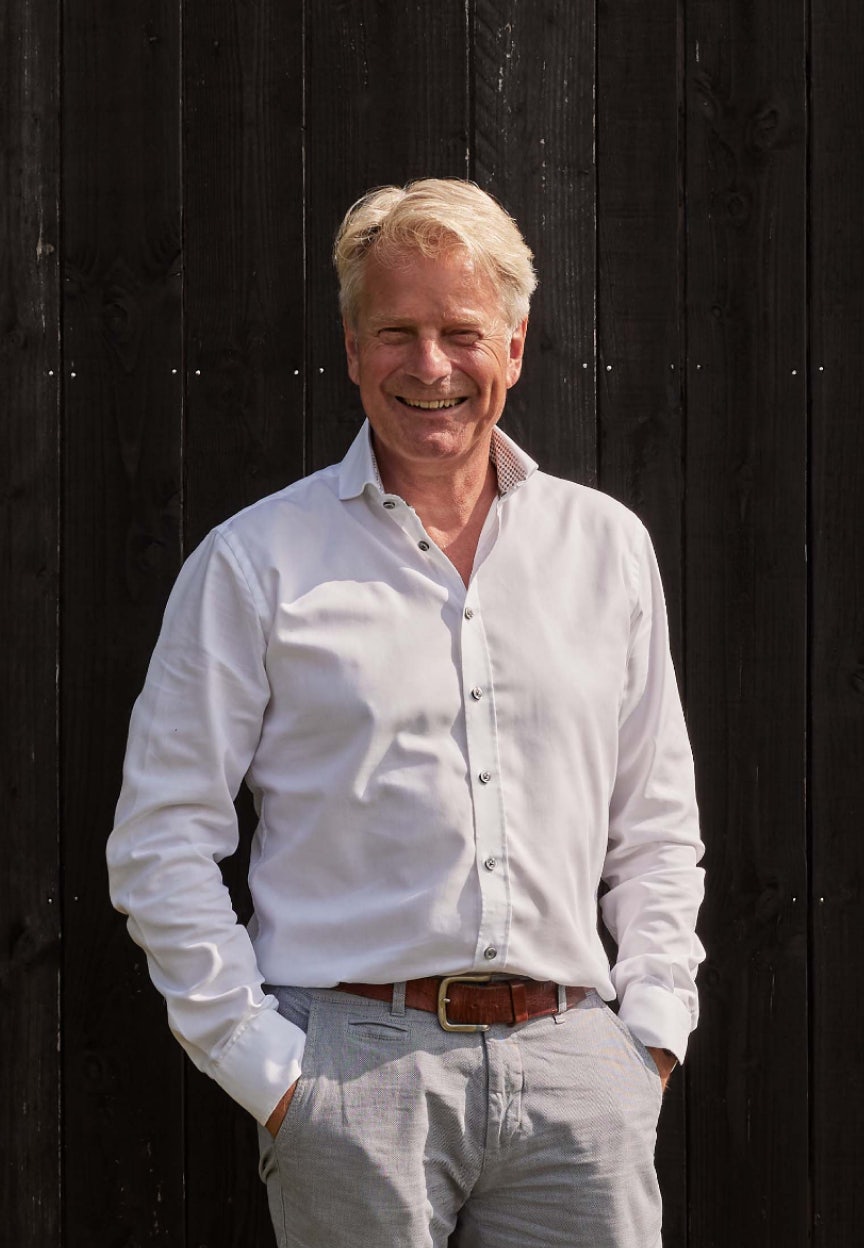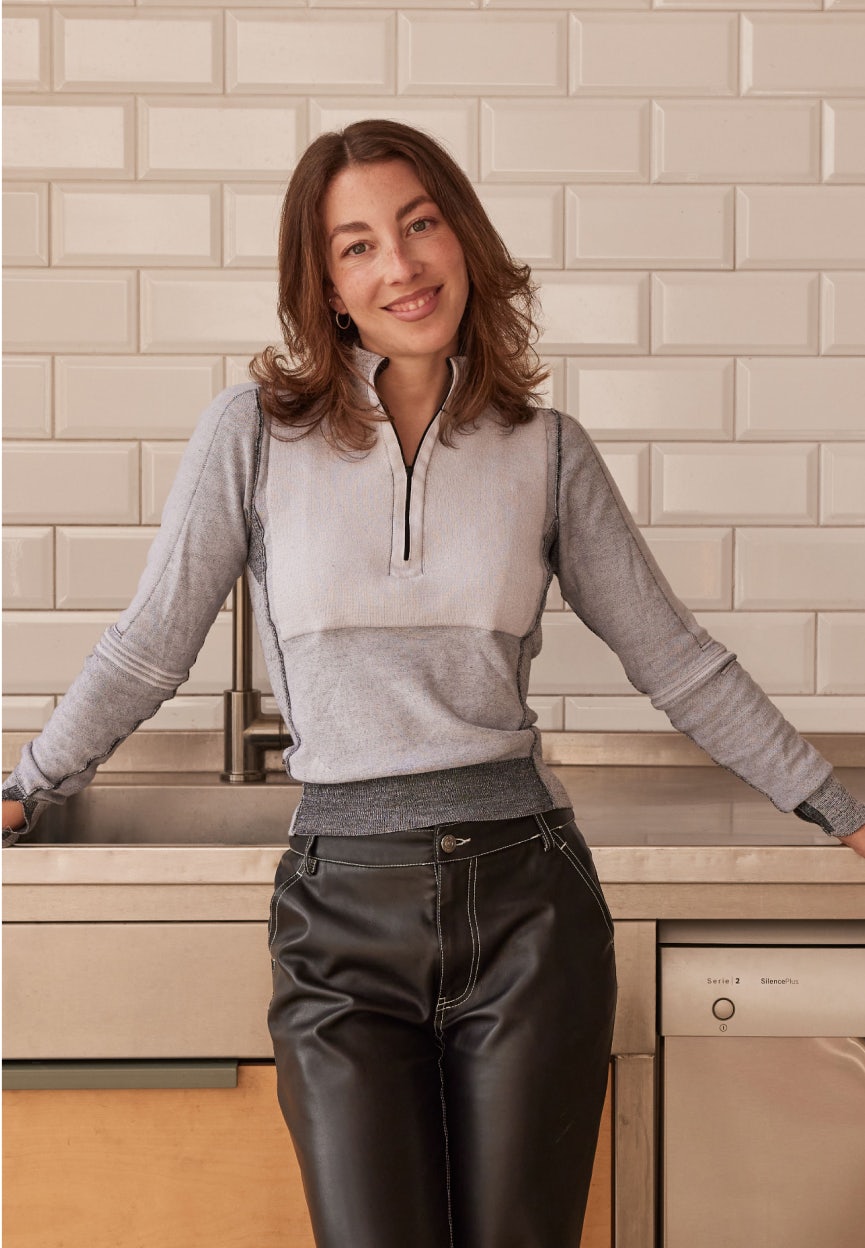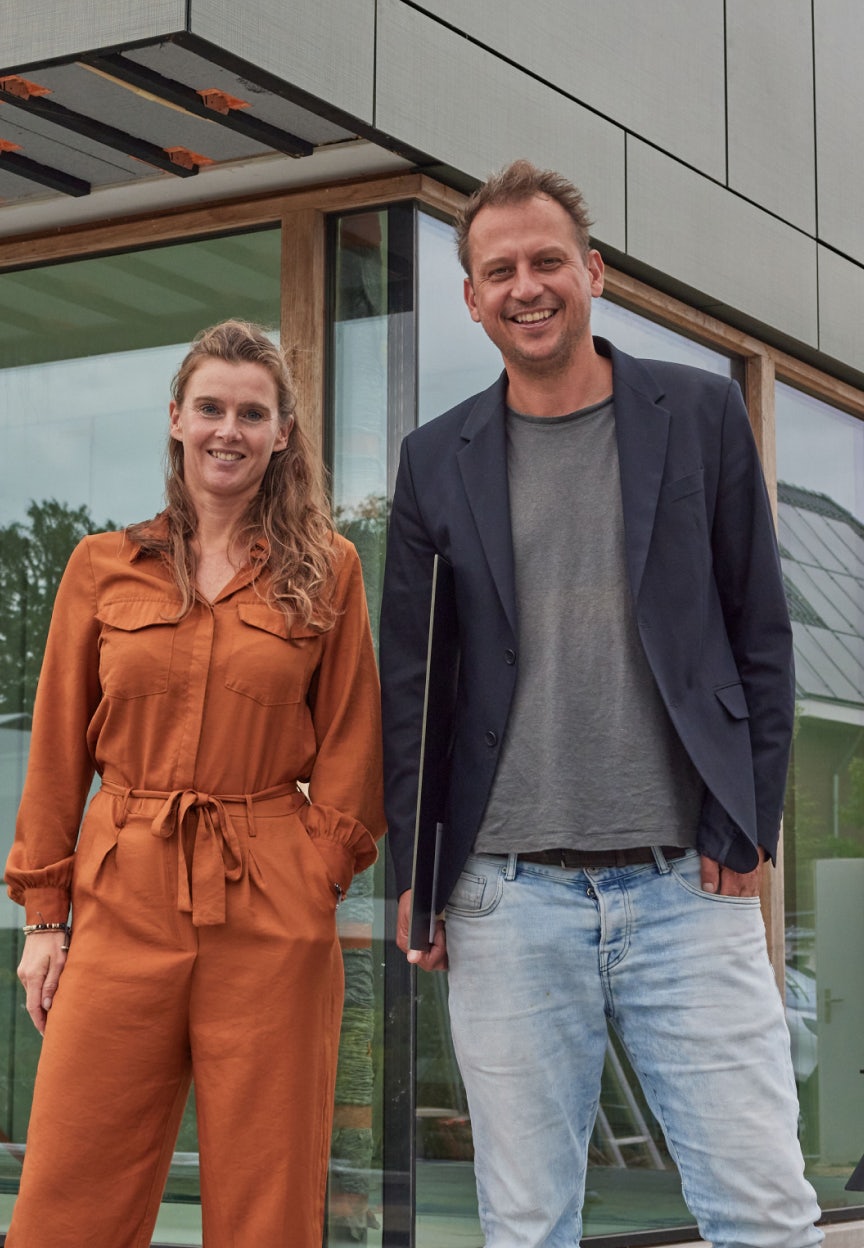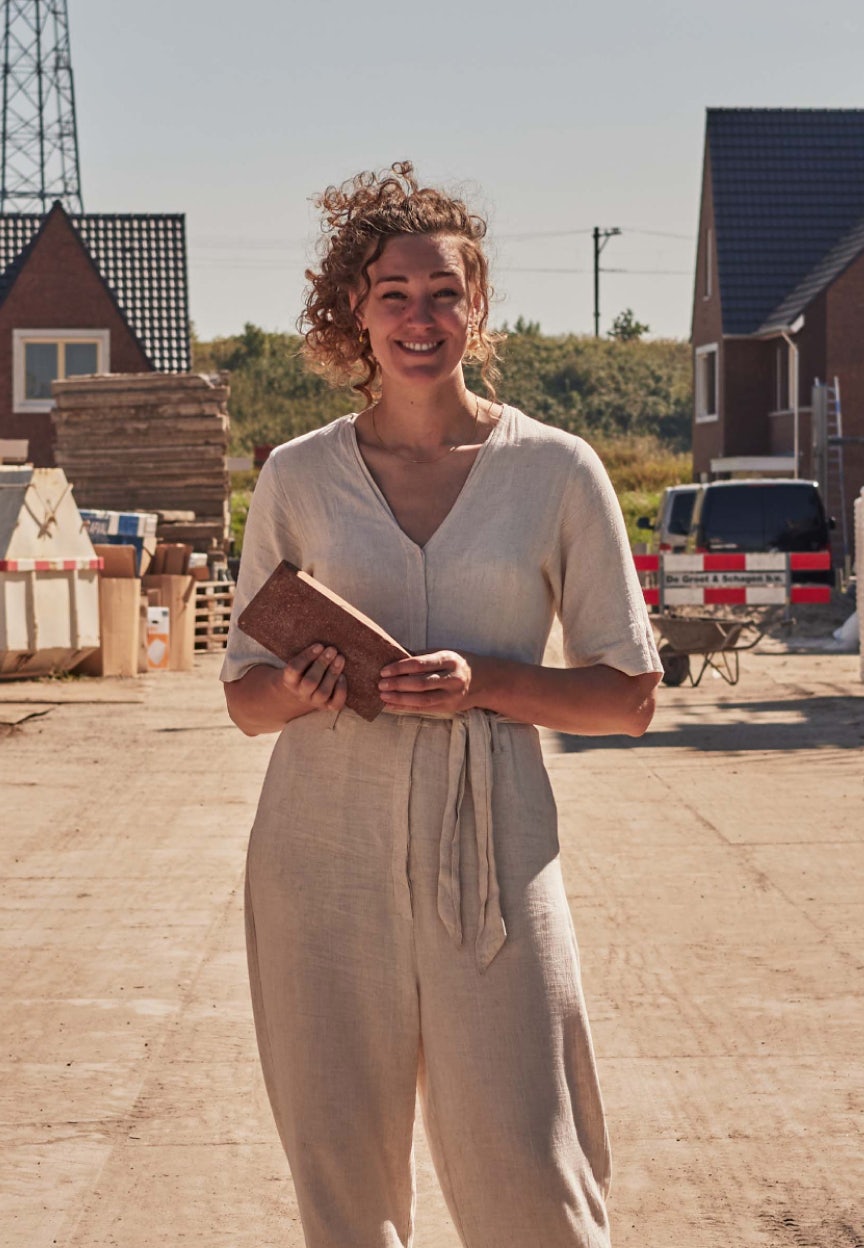
CELIUM™ da POLYBION
Axel e Alexis Gómez Ortigoza
Celium™ é um biotêxtil personalizável que pode muito bem tornar-se o novo padrão de excelência para aplicações na moda, calçado, vestuário desportivo e automóveis. A Polybion é uma empresa recente que descobriu uma forma de produzir este material versátil e natural, feito de celulose e cultivado com bactérias que se alimentam de resíduos agrícolas.
Todos os anos, são produzidos globalmente 23 mil milhões de metros quadrados de materiais alternativos ao couro e ao plástico. Apenas com os resíduos de manga do México seria possível produzir uma alternativa para cerca de 50% do abastecimento mundial de couro. Há muitas outras indústrias que podem beneficiar desta solução. Esta solução não só aborda questões ambientais, como a pecuária, o desperdício alimentar e a poluição plástica, como também é pioneira num modelo de produção circular.
Conversámos com os cofundadores Axel e Alexis Gómez Ortigoza (também conhecidos como os irmãos GO) sobre os seus valores, dilemas, oportunidades futuras e sonhos para o futuro.

Dois irmãos que partilham o interesse pela biotecnologia. Isso é inato ou adquirido?
Alexis: O nosso pai era um empreendedor tecnológico nos anos 80, por isso crescemos rodeados de tecnologia. Conversávamos sobre tendências tecnológicas durante o jantar. A nossa mãe é química e o Axel começou a trabalhar no laboratório dela muito novo. Eu tenho formação em finanças, mas o nosso interesse comum pela biotecnologia não é uma coincidência.
Axel: Também acho que o ambiente em que crescemos teve influência. Crescemos no México, nos arredores de Irapuato, que estava repleto de vida selvagem. O México é um dos países com maior biodiversidade do planeta. Por isso, onde quer que se olhe, há uma enorme diversidade de vida: plantas, insetos, répteis, mamíferos, tudo.
À medida que fomos crescendo e refletindo sobre o futuro da humanidade, percebemos que as alterações climáticas seriam o problema da nossa geração. Todos podemos sentir o calor, as secas, as tempestades. Acho que foi por isso que começámos a combinar a nossa formação em tecnologia e biologia. Para construir algo com um propósito que pudesse ajudar, pelo menos um pouco.
Querem combinar tecnologia e biologia para um propósito maior. Qual é esse propósito?
Alexis: Queremos cultivar um futuro melhor, uma célula de cada vez. Em concreto, queremos revolucionar a utilização global de materiais e encontrar melhores soluções para produzir qualquer tipo de material. Ao observarmos e aprendermos com a biologia, criamos alternativas melhores para aplicações comerciais. Acreditamos que é possível fazer as duas coisas: cuidar do nosso planeta e introduzir, em simultâneo, novas soluções comerciais. Talvez seja a próxima geração do capitalismo. O capitalismo não vai desaparecer, mas precisamos dessa mudança para formas mais sustentáveis.
Axel: Temos vários valores que nos orientam. Um deles é conseguir fazer mais com menos. A natureza é o nosso melhor exemplo: é muito eficiente. Nós, seres humanos, não o somos. Um exemplo disso é o desperdício alimentar: deitamos fora 30% dos alimentos que adquirimos. Isso não é eficiente. Outro valor é trabalhar com a natureza em vez de contra ela. Queremos dissociar o crescimento económico das emissões de carbono. Acreditamos que podemos utilizar tecnologia muito mais próxima da natureza e criar uma nova forma de civilização com melhor qualidade de vida.
Alexis: Trata-se de um paradigma totalmente novo de produção. A produção tradicional baseia-se na mineração: extrai-se ou explora-se um material, usa-se e deita-se fora, esquecendo-se depois dele. Queremos mudar isso para um método circular.
Que lição aprendeu com a biologia e como a traduz para a tecnologia?
Alexis: A lição é que a celulose é um material mágico! A celulose é o polímero mais produzido no planeta. Um material muito puro e natural. Para onde quer que se olhe, a natureza é composta por celulose. Ela dá suporte estrutural às plantas e às árvores, ajudando-as a manter a sua forma e a resistir às pressões externas. Previmos que deve haver uma razão para a mãe natureza escolher a celulose como seu bloco de construção.
Axel: A celulose é uma cadeia de glicose, ou açúcares, colados uns aos outros. Essa cadeia é chamada de polissacarídeo. A celulose é a forma mais pura, mas existem muitos polissacarídeos. Como a quitina, que compõe as cascas dos frutos do mar ou os exoesqueletos dos insetos. Ou a lignina. Se você observar o material vegetal, quanto mais macio ele for, menos lignina terá. Uma folha é 100% celulose. A casca de uma árvore tem cerca de 30% de lignina. Portanto, se combinarmos celulose com lignina, obtemos lignocelulose, que é a madeira. E assim, combinando celulose com diferentes materiais, podemos criar tudo o que vemos na natureza. O melhor é que também podemos criar esses materiais em laboratório. A celulose é como uma tela em branco com a qual podemos projetar muitas coisas. Podemos impactar tantas indústrias.
Axel: Descobrimos um processo muito eficiente para produzir celulose 100% pura, através de bactérias que se alimentam de açúcar proveniente de resíduos agrícolas de frutas. Estas bactérias convertem o açúcar em pequenas fibras de celulose, ou seja, celulose bacteriana. Atualmente, utilizamos resíduos de frutas, como cascas de manga provenientes de grandes operações de produção no México. No entanto, em todos os lugares do planeta onde há seres humanos, há agricultura e resíduos que podemos utilizar. Desde que contenham glicose, ou seja, açúcar. É uma solução pronta a usar. Pode adaptá-la a qualquer local onde haja resíduos alimentares.


Então, encontrou uma solução de material natural e de baixo impacto: a celulose bacteriana. Que indústrias pretende mudar com ela?
Axel: Neste momento, estamos focados na indústria do couro. O nosso material atual é uma boa alternativa ao couro. É ainda mais sustentável do que outras alternativas, como o micélio, porque é mais versátil e tem um ciclo de vida mais longo. E é muito mais escalável. É facilmente personalizável em cor, textura e resistência à água. Oferece uma opção têxtil luxuosa e sustentável.
Alexis: O couro é amplamente utilizado em várias indústrias, como moda, roupa desportiva e automóvel. É um mercado grande e global. Mas, no futuro, poderíamos usar a celulose bacteriana para muitas coisas diferentes. Também podemos fazer papel para a indústria de celulose. É uma indústria enorme e massiva que depende do cultivo de florestas por 30 ou 40 anos. Em vez disso, podemos obter celulose pura a partir de resíduos em 20 dias! Em grande escala, sem cortar árvores. E sem adicionar muito ácido.
Que impacto poderá a sua solução ter na indústria do couro?
Axel: Gostaria de salientar que nos concentramos numa solução tão versátil que pode ter um impacto em várias indústrias. No entanto, decidimos começar com uma indústria muito grande, como a indústria do couro, visto este ser amplamente utilizado em diversos produtos de consumo. Todas as opções de couro vegano atualmente disponíveis no mercado contêm plásticos, o que também não é sustentável. A isso chamamos couro sintético. Todos os anos, são produzidos 23 mil milhões de pés quadrados de couro e de couro sintético em todo o mundo.
Oferecemos um novo substrato biológico: a nanocelulose. Não há plástico envolvido. Além disso, podemos utilizar a mesma infraestrutura das curtumes de couro animal para o curtir, o que torna a expansão uma opção sem grandes investimentos. Podemos até usar cervejarias, visto tratar-se de um processo líquido. Podemos revolucionar toda a indústria.
Alexis: Para a indústria do couro, fizemos um pequeno cálculo. Se transformarmos apenas os resíduos de manga no México em produção têxtil Celium, poderíamos fornecer cerca de 50% do abastecimento mundial de couro. E isto apenas com os resíduos de manga no México. Quando avaliámos o ciclo de vida da nossa solução, ficou provado que esta é o biomaterial ou têxtil mais sustentável do planeta. É ainda mais sustentável do que outras alternativas, como o micélio, pois tem um ciclo de vida mais longo. É o mais sustentável e circular possível.
Podem explicar-nos como produzem o Celium como alternativa ao couro?
Axel: Sim! Utilizamos cascas de manga provenientes de grandes operações de produção de alimentos embalados no México. Elas deitam fora toneladas e toneladas dessas cascas. Colocamos os resíduos da fruta numa incubadora, que é uma sala enorme muito semelhante a uma estufa, onde controlamos o ambiente. Aqui, os resíduos são convertidos em alimento para as bactérias. Consoante a espessura final do couro desejada, deixamo-lo lá durante 10 a 20 dias. "Cultivamos" o material e, depois, podemos colhê-lo. O que obtemos é um hidrogel com um aspeto semelhante ao de um pedaço de carne.
Alexis: A seguir, vem a segunda fase de produção, que é o curtimento. É o mesmo equipamento que seria utilizado tradicionalmente, mas com uma química diferente, visto tratar-se de um material distinto. Utilizamos muito menos água, energia e produtos químicos não tóxicos. Não utilizamos metais, como o cromo, o alumínio ou os aldeídos. Em suma, cultivamos bactérias para produzir nanocelulose e, em seguida, curtimos a nanocelulose para a converter num novo tecido que pode ser utilizado como alternativa ao couro. A este material acabado chamamos Celium™ - Celulose Cultivada Premium. Adquirimos todos os materiais num raio de 60 quilómetros. Não só os resíduos de frutas, como também os produtos químicos ecológicos que utilizamos para curtir.
Utilizamos cascas de manga provenientes de grandes operações de produção de alimentos embalados no México.
Já estão a vender este material? Já existem produtos no mercado feitos de Celium?
Alexis: Sim, mas não estamos a vender um produto acabado ao consumidor. Dito isto, a GANNI, uma das marcas dinamarquesas mais badaladas, já está a trabalhar connosco. Lançaram um blazer "Celium™" e alguns protótipos de malas que foram apresentados durante a Semana da Moda de Copenhaga, em Janeiro. Atualmente, estão a trabalhar para incluir o Celium™ na coleção de 2025. Recebemos muitos comentários de pessoas que adoram a aparência do material. Para nós, estas validações e protótipos do mundo real são muito importantes.
Axel: Precisamos de histórias de sucesso como esta, que envolvam empresas de biomateriais, como a Polybion, e marcas globais icónicas, como a GANNI." Estas são verdadeiras fontes de esperança para um mundo de materiais mais sustentáveis. Juntos, podemos demonstrar que este tipo de tecnologia pode ser utilizado para criar produtos bonitos em larga escala.
Está pronto para que mais marcas comecem a usar o seu tecido?
Alexis: Sim, mas não trabalhamos com qualquer pessoa. Temos uma lista de clientes com objetivos sólidos de sustentabilidade, com quem queremos trabalhar e que também querem trabalhar connosco. Essa lista continua a crescer e mais pessoas são convidadas.
Axel: Consideramos que é nossa responsabilidade criar um material com bom desempenho, duradouro e sustentável. Por exemplo, damos a uma marca de moda o Celium para trabalhar como alternativa ao couro que normalmente usariam. No entanto, o Celium é provavelmente apenas um dos materiais de que necessitam para o seu produto. A forma como o utilizam é decisão e responsabilidade deles. Isto significa que a sustentabilidade do produto final dependerá da marca que utilizar o nosso material. Cada marca tem objetivos e requisitos diferentes e queremos ajudá-las a promover mudanças positivas.

Existem outros desafios com os quais a nossa comunidade pode ajudar?
Alexis: Eu diria que o próximo passo importante para nós é prepararmo-nos para as coleções comerciais da indústria da moda. Estamos a trabalhar arduamente para superar os desafios mais recentes e estar prontos para colaborar com marcas maiores e mais numerosas.
Axel: Estamos quase lá. Para alcançar uma produção em maior escala, o nosso material tem de ter um bom desempenho, ser esteticamente agradável e ser sustentável. Estas três coisas têm de estar presentes. O nosso material já é produzido industrialmente, mas queremos melhorar os nossos métodos de curtimento. Como a celulose que produzimos é hidrofílica, ou seja, absorve água, o revestimento pode começar a descascar em ambientes húmidos. Precisamos de mais tempo para encontrar os métodos mais adequados. A indústria do couro também demorou muito tempo em termos de investigação e desenvolvimento, portanto, penso que estamos no caminho certo.
Alexis: Além disso, o que fazemos tem de agradar ao consumidor. Os produtos criados com o nosso material têm de ser sensuais, atraentes e bonitos. O Celium™ representa uma nova categoria com uma estética totalmente diferente, que não seria possível obter com couro ou plástico. É facilmente personalizável em termos de cor, textura e resistência à água, oferecendo uma opção têxtil luxuosa e sustentável. É muito importante para nós termos clientes como a GANNI, que são corajosos o suficiente para abraçar esta nova estética e colocá-la no mercado. Podem ajudar-nos a criar consciência e a permitir que as pessoas reimaginem o que é o couro e a sua origem. Experimentem coisas diferentes.
Qual é a mensagem que gostariam de partilhar com todos os que lerem esta entrevista?
Axel: Diria que a mensagem é que é possível uma civilização melhor que possa coexistir com a natureza. Temos de esquecer o que aprendemos sobre materiais e métodos de fabrico, pois estávamos errados. Há formas melhores de colaborar com a natureza em vez de apenas tirar proveito dela e precisamos de abrir os olhos para as ver.
Alexis: Sim, acho que a próxima vaga de aplicações de consumo pode vir da natureza. Devemos projetar em conjunto com a natureza e difundir novas ideias. Podemos projetar produtos tendo em conta a biologia e a escala em cada etapa do processo, resolvendo assim muitos dos problemas que a civilização enfrenta com os materiais. Ao fazê-lo, podemos criar uma nova civilização. Em suma, devemos estabelecer uma parceria com a natureza para criar a próxima vaga de aplicações muito interessantes.
Histórias curtas

ForestGuard
ForestGuard is an advanced wildfire prevention system. This device detects forest fires within the first 15 minutes and helps communities worldwide to protect their valuable forests and natural resources. An integrated monitoring system can help to manage a fire before it starts or turns into a full-blown fire.

Secrid Talent Podium - Electric Skin
Electric Skin is a speculative idea that can change how we relate to daily electronic objects, such as our phones. A team of female biodesigners use bacteria that naturally produce electrical proteins for use in electronics. It could be possible to make compostable electronics by integrating these proteins into algae-based biomaterials.

Secrid Talent Podium - Fungi Force
Entrepreneur Frans van Rooijen and scientist Dr. Michael Sailer are launching a varnish made from natural raw materials.

Secrid Talent Podium - Vorkoster
To combat food waste, Kimia Amir-Moazmi is working on a product that allows consumers to see for themselves whether food is still safe to eat.

Secrid Talent Podium - Solarix
Solarix designs and produces aesthetic solar panels as façade cladding.

Secrid Talent Podium - Claybens
Emy Bensdorp is developing a technique to transform clay soil contaminated by PFAS into 100% clean bricks.

